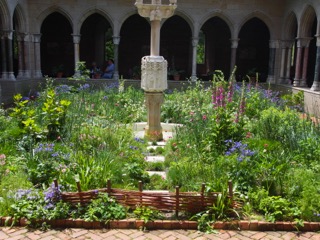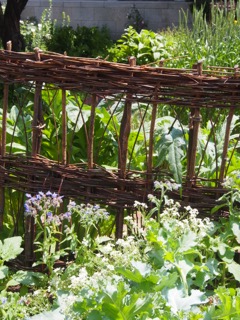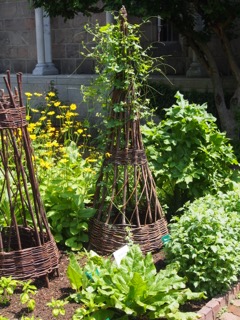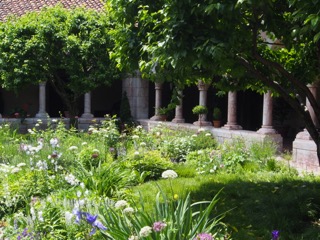Dedicated to the ‘art, architecture and gardens of medieval Europe’, I was first on a mission to visit The Met Cloisters some 20 years ago when my fascination with both medieval gardens and willow structures was at its peak. Despite the early drought years at Glenmore, I was still determined then to create a pretty, lush, rather wild and romantic garden, interspersed with willow panels and wigwam structures, with edible, medicinal and scented plants.
In fact…..for awhile, that was the inspiration behind what is now the Kitchen Garden (during its in-between phase when I realised that being a working mother was not going to allow me to grow veg on the scale I’d hoped and the Kitchen Garden retreated to a small patch directly outside the kitchen door!). Inspired by these fantasies, each ‘square’ to either side of the just-getting-established apple arch was planted with a central quince tree, surrounded by all manner of herbs from Clarey sage to borage and comfrey…..and glorious ancient spring flowering roses, like the Damasks Isphahan and Trigintipetala, as well as various Moss varieties. For a few years it was heaven, though always the last area I got around to weeding and mulching (though to this day I plant the seed each year that I collected from the first Purple Podded Dutch peas that I encouraged to trail over a twig panel fence). Over the years it also dawned (gosh I’m a bit slow sometimes!), that in reality this style of garden was defeating me in our climate – I became wiser (needless to say older)….and it was during these years that the rest of the garden evolved (by necessity and experience) into what it is today…..it may not be my original vision, but perhaps it is more ‘original’ because of it.
Of course I still go nutty about the gardens that inspired me then – I always will, and the gardens at The Met Cloisters are typical of my old favourites. And not just because of their style, but because of the history of the design that underpins them: “In a monastery, a cloister is a square or rectangular open-air courtyard surrounded by covered passageways. The yard enclosed within these arcades is known as a garth. In a medieval monastic complex, the garth was often situated to the south side of the church, providing a sunny, sheltered place where the monks or nuns could enjoy nature without leaving the monastery”. The plan of the Cuxa Cloister (above) “is typically medieval. A fountain is set at the centre of the crossed paths that divide the garden into quadrants, each with a grass plot and a pollarded crab apple tree. The medieval pleasure garden, with its borders of plants chosen for beauty and fragrance, is the ancestor of our own ornamental gardens”. (abbreviated from the Met Gardens’ description).

The Trie Cloister Garden (above) evokes an idealised version of a flowering meadow….“the joy the medieval world felt upon the return of spring, expressed in their verdant, millefleurs tapestries, allegorical poems and paintings…..a place of unbridled and untamed nature”. While in contrast, “the medieval apothecary and vegetable gardens were orderly, with pleasing symmetry and balance”, as seen in The Bonnefont Cloister Herb Garden, “with plants grouped and labelled according to their medieval use, whether in cooking, medicine, art, industry, housekeeping or magic. Many herbs, trees and flowers were used symbolically as well as practically”.
Er sorry….getting a bit carried away! This is why I should not start these things…..oh how I would love to while away the day just reading…..these descriptions carry me off into another realm…..

Anyway, aside from all the symbolism and fragrance, fruit, herbs and flowers……there are plant supports of every description to be found in this exquisite collection of small gardens. As this visit was unplanned and very quick, I didn’t take very many photos (I know I have gazillions in a hefty album from last time – pre-digital!). But seeing the plethora of panels and hurdles, obelisks and wigwams of every description….well….I couldn’t help but slip in this post with Penny’s upcoming Willow Workshop on the agenda!

Maybe, just maybe….I can figure out a way of resurrecting some of my old ideas……!!!

